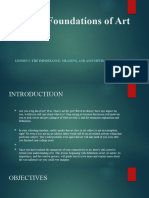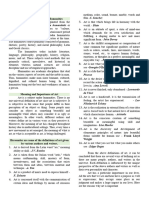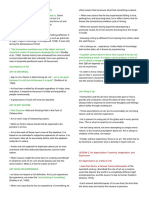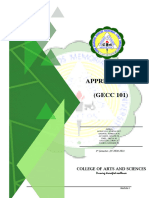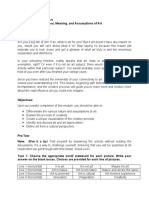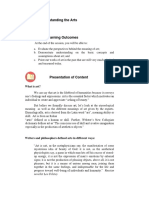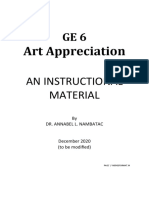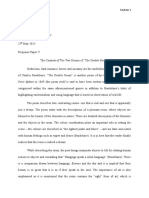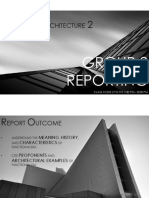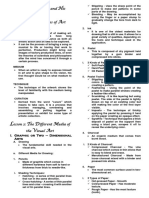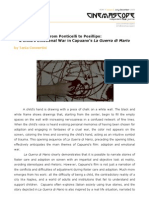ART 002 : ART APPRECIATION
J.R. | BS Psychology | 2nd Semester | Preliminary Examination
ART Example:
Etymological Derived from the Latin word “ars”, Beauty and Form: Leonardo da Vinci’s
Meaning meaning skills or craft. “Mona Lisa” (1503 - 1506)
Example: traditional craftsmanship and Emotional Impact: Vincent van Gogh’s
visual arts. “Starry Night” (1889)
Philosophical John Dewey’s “Art a Experience” (1934):
Perspective Art is a culmination of human PURPOSE OF ART
experiences, emotions, and
interactions, emphasizing it as a ★ Religious and Spiritual: Art serves worship, rituals,
process rather than a product. and spiritual expression across faiths, seen in
religious iconography, sacred architecture, and
Guiller’s “Image to Meaning”: Artworks ceremonial objects.
are analyzed for their capacity to ★ Political: Art acts as propaganda, activism, and
convey complex social and historical social commentary, advocating for causes and
narratives beyond their visible subject. challenging norms through political murals, protest
art, ettc.
Example: Marcel Duchamp’s “Fountain” ★ Social and Cultural: Art explores cultural identity,
(1917) reflecting and celebrating cultural narratives,
”Fountain” is a porcelain urinal signed landscapes, and contemporary diversity.
“R. Mutt” and was presented by Marcel
Duchamp as a work of art. It was SIGNIFICANCE IN SOCIETY
submitted to the Society of Independent
Artists in 1917, causing a major ★ Self-expression and Identity: Art facilitates
controversy and challenging traditional personal growth, self-reflection, and cultural pride,
notions of art. allowing individuals and communities to express
and communicate their identities.
Cultural and Arts serve as an expression, ★ Catalyst for Change: Art inspires societal
Historical communication, and reflection of transformation by raising awareness and
Views societal values conveying narratives, challenging norms sparking discussion and actions
histories, and cultural traditions. around social, political, or cultural issues.
★ Bridge Between Cultures: Art transcends cultural
Example: Honours and Fleming’s “A boundaries, fostering cross-cultural understanding
World History of Art”: Historical context and appreciation through cultural exchange and
influences the interpretation of art’s dialogue.
content across different cultures and
epochs. NATURE OF ART
Aesthetical Art is defined by its capacity to evoke Art is a creative activity that expresses imaginative or
Perspective sensory, emotional, and intellectual technical skill. It produces a product, an object. The
responses through its beauty and product of art is called a work of art. It includes drawing,
expressive qualities. This perspective painting, sculpting, photography, performance art, dance,
focuses on the visual, auditory, and music, poetry, prose and theatre.
overall experiential aspects of art,
emphasizing the aesthetic experience
as central to its value and significance.
Key Elements of the Aesthetica
Perspective:
1. Beauty and Form
2. Emotional Impact
3. Sensory Experience
4. Expressiveness
1
�ART 002 : ART APPRECIATION
J.R. | BS Psychology | 2nd Semester | Preliminary Examination
No matter what form art is manifested - be it through
CREATIVITY
painting, dance or music — it is up to the artist to choose
Creativity refers to our instinctive and intuitive power as the how they express themselves, what expressions they'll
highest form of species. Creativity is universal. This means share, and which ones they will keep to themselves.
that art does not only exist in humans, but also in other
creations. It is evident even in a typical Filipino backyard
ASSUMPTIONS ABOUT ART
that various species create and construct. Think of the
creative formations of Maya birds in the sky. Observe how 1. Art is Everywhere: This means that art can be
chickens or ducks beautifully assemble their nests. Insects found in many places around us, not just in
like ants build their anthills. Spiders weave their intricate museums or galleries. It can be in paintings,
webs. sculptures, musc, dance, and even in everyday
objects like clothes and buildings.
2. Art is Not Nature: This means that art is different
IMAGINATION
from the natural world around us. While nature
Imagination is the ability to produce and simulate novel includes things like trees, animals, and mountains,
objects, peoples, and ideas in the mind without any art is created by people to express ideas and
immediate input of the senses. Imagination is the ability to emotions using different materials and techniques.
form a mental image of something that is not perceived 3. Art is Imitating and Creating: This means that
throughout the five senses. It is the ability of the mind to artists often observe the world around them and
build mental scenes, objects or events that do not exist, are then use their imagination and skills to create
not present, or have happened in the past. Imagination something new. They might paint a picture of a
manifests in various degrees in different people. It is also flower they see in a garden, or they might sculpt a
described as the forming of experiences in one’s mind, statue of an animal they admire.
which can be re-creations of past experiences such as vivid 4. Art Perfects Nature: This means that sometimes
memories with image changes, or they can be completely art can make things even more beautiful or
invented and possibly fantastic scenes. Imagination is a meaningful than they are in nature. For example, a
cognitive process used in mental functioning and painting of a sunset might capture the colors and
sometimes used in conjunction with psychological imagery. feelings of the moment in a way that makes it even
It is considered as such because it involves thinking about more special than seeing the sunset itself.
possibilities. Imagination, however, is not considered to be 5. Art's Message is Universal: This means that art can
exclusively a cognitive activity because it is also linked to be understood and appreciated by people from
the body and place, particularly that it also involves setting different places and cultures. Even if someone
up relationships with materials and people, precluding the doesn't speak the same language as the artist, they
sense that imagination is locked away in the head. can still feel the emotions and ideas that the
artwork is trying to convey.
EXPRESSION
FUNCTION OF ARTS
Expression is the ability to convey meaning. It involves low
level skills such as spelling punctuation, capitalization, and 1. Personal/Emotional
grammar, but also high level composition skills such as ★ Self-expression: This means showing your
planning. organization, determining content, and revision to feelings, thoughts, or ideas through art. For
express information effectively. Today's society is going example, painting a picture or writing a
through challenging times across the globe and art has poem about how you feel.
contributed to a reaction towards local, as well as national ★ Emotional Release: Art can help people let
and international issues. With a range of talent, artists are out their feelings in a healthy way. For
painting ideas that many choose to ignore, using their art instance, drawing or writing when you're
as their voice to react to the injustices they see in this sad or angry can make you feel better.
world. Within its nature, art has no rules. There are no ★ Personal Growth: Creating art can help you
guidelines to express yourself. Art is meant to be the way learn new things about yourself and grow
the artist wants it to be, and art could be a reaction to as a person. When you practice art, you get
outrage to established systems. But just because art could better at it, and you also learn about your
be a reaction to what's going on, does not mean it has to be. strengths and what you enjoy.
Different artists have different stories to tell and different
ideas to get across through their art. Art is controversial yet
peaceful, simple yet bold.
2
�ART 002 : ART APPRECIATION
J.R. | BS Psychology | 2nd Semester | Preliminary Examination
2. Cultural
BASIC PHILOSOPHICAL PERSPECTIVE ON ART
★ Preserving Traditions: Art can help keep
customs and practices from the past alive.
ARTS AS MIMESIS
For example, making traditional crafts or
performing dances that have been passed The concept of art as mimesis refers to the idea that art is
down through generations. an imitation or representation of reality. Originating from
★ Fostering Identity: Art can show who you are ancient Greek philosophy, particularly from the works of
and where you come from. It can include Plato and Aristotle, mimesis involves the portrayal of the
things like wearing traditional clothing or physical world, human actions, or natural phenomena in a
singing songs from your culture. way that reflects or mimics the real world. Plato believed
★ Promoting Values: Art can teach important that art was nothing but an ideal state. For instance, an
lessons and values. For instance, paintings illustration on the concept of a table that runs into two
or stories might teach about kindness, categories which are thing and actual object.
honesty, or bravery.
3. Social The thing refers to an idea or the essence of a table itself. It
★ Commentary: Art can be used to talk about is simply the internal properties of a table. The idea of a
important issues in society, like fairness or table exists only in the mind and no physical substance
equality. Artists might make paintings or appears. On the other hand, an actual object refers to the
sculptures that show their thoughts on physical substance qualities of a real table. Thus,
these topics. concerning beauty and truth on art for Plato, this table in
★ Activism: Some art is made to try to change the real world would lack the perfection of an ideal table
things in the world for the better. For even though the finest craftsman already achieved his
example, making posters or songs to purpose of creating a table. For him, it reduced the ultimate
protest against unfairness or pollution. idea of thing.
★ Raising Awareness: Art can help people
learn about things they might not know
ART AS REPRESENTATION
much about, like endangered animals or
different cultures. Artists might create Aristotle believes that art should be judged by the accuracy
exhibitions or performances to share this and effectiveness of its imitation. This means that the
knowledge. subject matter of art should be an accurate representation
4. Decorative/Aesthetic of reality and that it should represent the things that exist
★ Beautification: Art can make things look in the world. For example, when painting a landscape, the
more attractive or beautiful. For example, artist should strive to capture the colors, shapes, and
decorating a room with paintings or adding textures of the natural environment as accurately as
designs to clothes. possible.
★ Visual Appeal: This means that art is nice to
look at. It can include things like colorful
ART AS PURPOSIVE WITHOUT A PURPOSE
paintings, intricate patterns, or graceful
sculptures. According to Immanuel Kant, art can be considered
5. Spiritual purposive in that it seems to have been created with
★ Religious Practices: Art has often been used intention or design. However, it lacks a specific purpose or
in religious ceremonies and rituals. This can practical function beyond the aesthetic experience it
include things like making sacred paintings, provides. This idea emphasizes the intrinsic value of art and
sculptures, or music. beauty, suggesting that true aesthetic appreciation is
★ Ceremonies: Art can be part of special detached from utilitarian or instrumental concerns.
events or celebrations, like weddings or
festivals. People might use art to decorate
spaces or perform traditional dances.
★ Spiritual Expression: Some art is made to
show feelings or beliefs about things that
are bigger than just everyday life. For
example, making sculptures or paintings
that represent ideas about the soul or the
afterlife.
3
�ART 002 : ART APPRECIATION
J.R. | BS Psychology | 2nd Semester | Preliminary Examination
2. Abstract: Contrary to representational art, abstract
ART AS DASEIN
pieces do not directly depict identifiable subjects.
Dasein is Martin Heidegger's way of referring both to the Instead, they utilize shapes, colors, and forms to
human being and to the type of Being that humans have. evoke emotions, provoke thoughts, or convey
Its essence lies in its existence. It can respond to its messages. In abstract art, the focus shifts from
circumstances, thereby choosing its 'Being'. 'Dasein' is depicting tangible objects to exploring the
about the human being and its place in the world. Dasein is interplay of visual elements and their impact on the
essentially in the world, because it continually interprets viewer.
and engages with other entities and the contexts in which
they lie. Only Dasein makes the world a unitary world at all,
CONTENT
rather than a collection of entities. Dasein is the whole
human being, and makes no distinction between body and The content of a work of art delves into its deeper meaning
mind. Heidegger rejected any purely psychological realm. or message, addressing the question, "What does it mean?"
This deeper layer of significance can be derived from
Art as Dasein refers to the idea that art is a reflection of various sources:
human existence and our engagement with the world. It
emphasizes that art is not just about aesthetics but reveals 1. Symbolism: Artists frequently employ symbols to
deeper truths about our lives and experiences. Dasein, a represent ideas, emotions, or qualities beyond their
term from philosopher Martin Heidegger, means literal appearance. These symbols imbue the
"being-there" and highlights our interconnectedness with artwork with layers of meaning, inviting viewers to
our surroundings. Through art, we confront our existence, interpret and engage with the piece on multiple
authenticity, and the transient nature of life, prompting levels.
reflection on our own realities. For example, a simple still 2. Context: The cultural, historical, and social context
life can evoke profound thoughts about existence and surrounding the creation of art significantly
temporality. influences its content. Art is often a reflection of
the time, place, and society in which it was
produced Understanding the context provides
ART AS SUPREME OVER MORALITY
valuable insight into the intended message or
Art and Morality: Benedetto Croce argued that art should interpretation of the artwork.
not be judged by moral standards because the purposes of 3. Artist’s Intent: At the core of every artwork lies the
art and morality are fundamentally different. While morality artist's intent — their personal vision, thoughts, and
concerns itself with actions and their ethical implications, emotions that they aim to express through their
art concerns itself with the creation of beauty and the creation. The artist's intent serves as a guiding
expression of intuition. Hence, art should be appreciated force, shaping the content of the artwork and
for its aesthetic value rather than its adherence to moral influencing how it is perceived by the audience. By
norms. understanding the artist’s perspective and
motivations, viewers can gain deeper insights into
the artwork’s significance and appreciate the
UNDERSTANDING THE SUBJECT AND CONTENT OF
creative process behind it.
ART
In essence, understanding both the subject and content of
SUBJECT
art involves unraveling the visual elements and delving into
The subject of a piece of art encompasses the identifiable the underlying messages, symbols, and contexts that
objects or themes portrayed within it, providing an answer shape its meaning and impact. Through thoughtful analysis
to the question, "What is it about?" This can manifest in two and interpretation, viewers can engage more deeply with
main forms: artworks, enriching their experience and fostering a
greater appreciation for the diversity and complexity of
1. Representational: Involves the portrayal of artistic expression.
naturalistic or realistic forms such as landscapes,
portraits, and still life. These subjects are
recognizable and often drawn from the observable
world.











